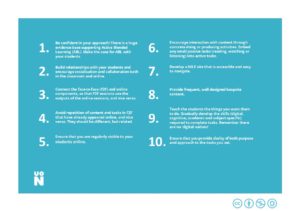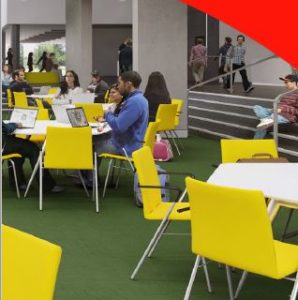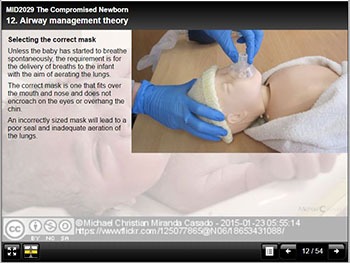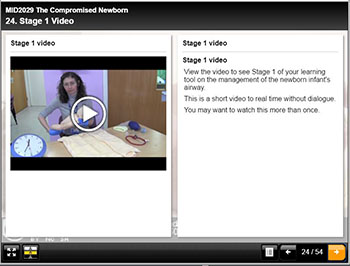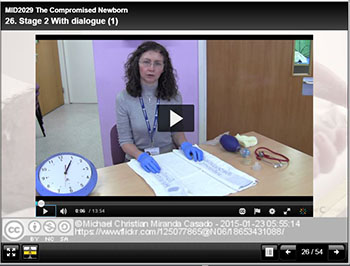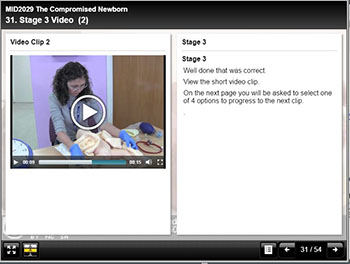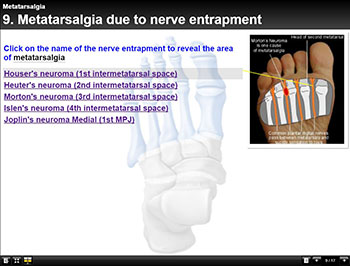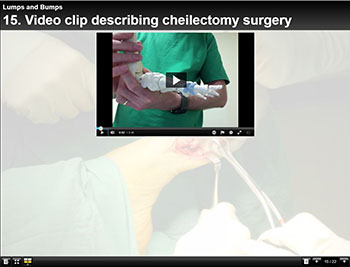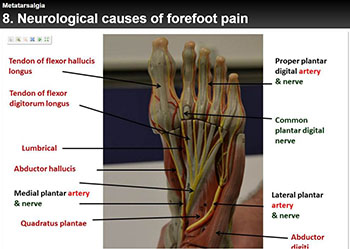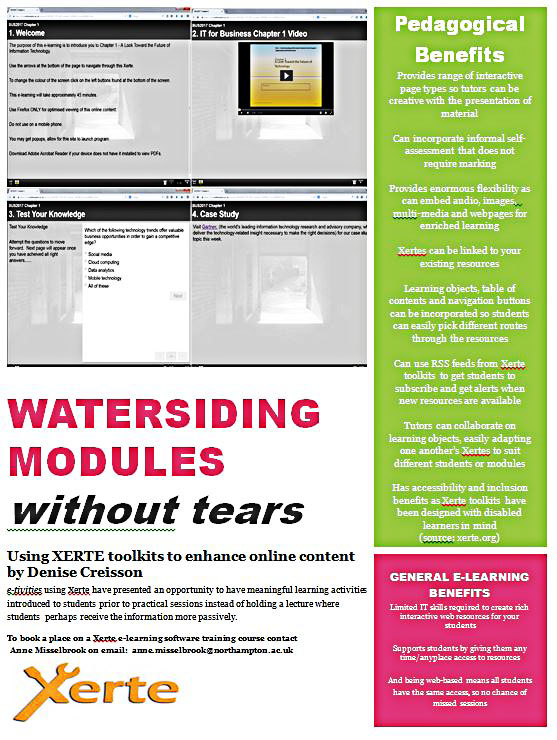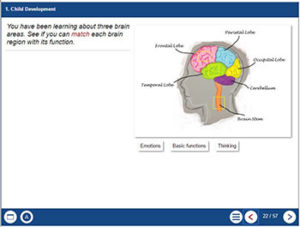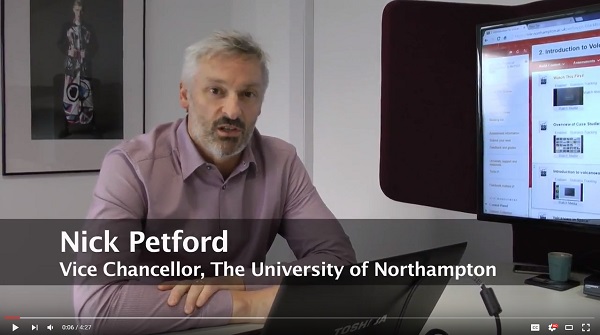On 18th May, 2017, Simon Sneddon was presented with the Best NILE Site Award as part of the Student Teaching and Representation (STAR) Awards evening.
(left to right) Simon Sneddon collecting his award from Rob Howe (Head of Learning Technology)
NILE is an essential part of the student online experience. This award was to recognise staff members who have made a significant effort with their NILE site setup and use.
Students were asked to nominate against the following criteria:
• The site design and navigation assists students to easily find the content they are looking for.
• The content and resources on the site cover all key areas required.
• Tools for discussion and collaboration are effectively used throughout the site.
• Assessment and feedback is clear and well managed through the site.
• The tutor’s Nile Site has an element of innovation which has enhanced engagement
The full list of nominees and the student comments are shown below – congratulations to all of these and to all of the staff that have worked to support them.
Alasdair Gordon-Finlayson
The way Nile is used by Alasdair has been described as “truly innovative” as it is utilising most of the available components of the site. Alasdair uploads slides with voice overs, chapters for reading and videos covering related topics onto NILE which are well appreciated by students. He includes online tests which allow students to receive immediate feedback.
Mark Johnson
Mark provides a huge amount of information onto NILE, but organises it in such a way so that it is not daunting for students. All the content and resources are always uploaded on time so they are easy to find. He talks through all the sites and shows students where to find all the information. Mark utilises message boards to communicate with students and regularly updates these with information on the subject matter and even external job opportunities. All emails are replied to efficiently with the contact information provided on NILE. All feedback and grades are nicely structured so students know where to find all of their grades.
Melanie Cole
Melanie used NILE to create an online resource to prepare students for their practical assessments. She broke each learning stage down by demonstrating it on video, with added sound and commentary. Each element of the practical was explained clearly and then students were tested on it before they moved through the online learning resource. This learning tool was engaging, interesting, clearly explained and easy to follow. Students described it as the best way of learning a complex subject. The video, audio and online test was a fantastic way to reinforce knowledge.
Simon Sneddon
Simon has proactively designed and prepared the NILE site to be ‘Waterside Ready’, and offers a range of resources including videos, books, journals, and examples of previous assignments for guidance. He has striven to ensure that all students are aware of how to use the site by demonstrating it in sessions, and by clearly signposting each section of the modules and related tasks. On the NILE site, there is an online discussion board where students can discuss the topics and share resources covered. Simon frequently comments and posts updates encouraging students to read each other’s work and have a discussion on the issues raised. These tools for discussion and collaboration are highly effective throughout the site, not only because it is a different way of learning, but also it helps face to face students to share, and to read the work of distance learners, bridging the gap between both student groups. All module content is available at the start of term and so students can start planning ahead. Assessments and feedback have designated folders, which provide the breakdown of all assignments in a clear and accessible format.
Toby Purser
Toby uploads links to relevant media currently in the news linking to each topic. He uses a mixture of both interactive and teacher lead learning on the website with e-activities, videos and newspaper articles on NILE building upon content discussed during teaching. Each section of the module is separated into its own folder with a relevant picture which makes information easier to find. Toby uses active discussion boards where topics are tackled prior to the session. As well as written feedback which is easy to find, Toby uploads a 3 minute video clip where he personally talks through the strengths and weaknesses of each assignment and explains how students can improve.
Authors: Elizabeth Palmer, (University of Northampton, Learning Designer,) Sylvie Lomer, (University of Manchester, Lecturer in Education) and Ivelina Bashliyska (3rd Year Undergraduate Student and Assistant Researcher).
With thanks to Nadine Shambrooke and David Cousens for support with transcription and coding.
______________________________________________________________________
The University of Northampton has taken an institutional approach to learning and teaching through the widespread adoption of Active Blended Learning (ABL) as its new ‘normal’. To find out more please visit: https://www.northampton.ac.uk/ilt/current-projects/waterside-readiness/
However, student engagement has been highly variable, which has created a number of challenges for staff. Semi-structured qualitative focus groups have been undertaken with 201 undergraduate students across all the year groups and faculties during the academic year 16/17 based on a pilot study of 24 students in academic year 15/16. These focus groups have been looking at trying to uncover the students own perceptions and experiences of ABL in order to unpick the reasons behind varying patterns and engagements and to glean student insight into the factors that inhibit or encourage engagement with ABL.
The study has revealed a number of key factors which students identify as having significant impact on their engagement. Key success factors include effective pedagogical design, in particular establishing a clear and explicit relationship between online and face to face components of modules, and scaffolding the development of digital skills and literacies in the process of establishing online tasks. A strong relationship between staff and students is also critical, where students trust in the decisions and motivations of staff. This is signalled by following up on online tasks, providing feedback where relevant, and explicitly discussing the value of online tasks to module learning outcomes and employability skills. A key finding is that students’ conceptions of learning, teaching & knowledge impact on their engagement with ABL, and are not necessarily compatible with ABL principles. These factors are complex, interdependent and have varying loci of control. Staff can take a number of measures to increase the likelihood of student engagement, although certain factors remain ultimately within the agency of students. Understanding these issues is critical to the success of ABL.
The following artefacts provide the results of the study to date:
Read the Interim Report from the Main Study here:
For Ten Top Tips on how to design ABL to maximise student engagement:
Read the Pilot Study Report here:
Melanie Cole achieves tremendous praise from her students who undertook their study using the Xerte e-learning package.
Newborn airway skills teaching and learning
Second year student midwives are required to demonstrate knowledge and manual dexterity skills in key elements of newborn resuscitation while undertaking the undergraduate module ‘The Compromised Newborn’. All those responsible for the care of the newborn infant should be able to provide basic assistance including essential airway management to a baby that does not make a normal transition to extra- uterine life.
The ‘4 stage approach’ is a recognised tool to facilitate acquisition of skills in resuscitation of the newborn infant and is advocated by the UK Resuscitation Council (2015).
Stage 1 – a silent demonstration of the skill by the tutor, allows the learner to observe the skill to real time.
Stage 2 – a demonstration with the addition of tutor dialogue, allows deconstruction of the skill and provides rationale for techniques and the structured approach.
Stage 3 – another tutor led demonstration which encourages the learner to verbally predict the next step and provide commentary for the tutor.
Stage 4 allows the learner to perform the skill independently with tutor and peer support.
Planning an online teaching and learning package
With our future learning environment at Waterside and a shift towards blended learning in mind, I explored the prospect of combining video assisted technology with face to face teaching and learning. My aim was to provide Stage 1, 2 and 3 online and bring the students to the university to consolidate learning and practice new skills during scheduled tutor facilitated contact sessions in small groups. While Kaltura enables the students to engage with stages 1 and 2 in viewing pre-recorded demonstrations of the skill, the challenge was related to Stage 3 and in providing an opportunity for students to be able to engage and contribute online. I contacted Anne Misselbrook from the Learning Technology Team and during a meeting we discussed my requirements and vision for the online resource. Anne quickly identified the Xerte learning package as an e-learning tool that would support my needs and enable Stage 1, 2 and 3 to be delivered online.
Creating an online package
Andy Stenhouse helped me to create the video of the skill being performed in real time (Stage 1) and the video of the skill being performed with tutor dialogue (Stage 2). The video of the skill in real time was then spilt into 10 smaller clips to enable Stage 3 to be created. The students would then be able to view a small clip and choose an answer from a multiple choice question to predict what should happen next. A correct answer takes the student to the next clip while an incorrect answer takes them back to the beginning of Stage 3. The student has to answer each question correctly to get to the end of the sequence and they can have as many attempts as they wish, accommodating individual needs and learning styles.
Six months after I contacted the learntech team the final xerte was embedded into NILE within a series of timetabled learning units and was accessed by the pre-registration midwifery students in October 2016.
These are some quotes from the students who engaged in an online survey following uptake of the xerte learning tool:
Positive Comments
“I found this learning tool extremely helpful and it had the perfect mix of written information and pictures/videos. I feel this will really help me in my practical assessment, if you got a question wrong you had to go back to the beginning which I thought was a really good idea as it enabled you to revisit information that you may not have completely took in and allowed you to keep going over it until this information has stuck”.
“I think the xerte learning tool is of great benefit as it enabled me to go through the learning stages at my own pace and I am able to revisit the information as often as I want in preparation for my assessment. I especially found the videos useful and with these found the content easier to understand”.
“I thought it was extremely useful. The videos were excellent. A good variety of media used too which encouraged learning. I found it very helpful”.
“Overall this tool was brilliant to aid our learning and being able to go back to the videos and quizzes will be very helpful before the assessment”.
“I thought the learning tool was excellent and a great help to my understanding of the topic. So much better than reading a book about it”.
“I believe this to be an excellent method of learning, as you can view the correct way to manage the airway and view it as many times as you wish”.
“A really good learning tool. Easy to follow and in order, making it easy to revise and understand”.
“The videos were really good, easy to understand and clear”.
“I felt the videos very useful especially as I believe I am a visual learner”.
Suggestions for modification
“Instead of going back to the beginning when getting an answer wrong, perhaps just show it is the wrong answer and give another opportunity to select correct answer”.
“Having to go right back to the beginning if you had got a question wrong was slightly frustrating although it did make me remember information so there were definite pros and cons to that process”.
Concluding reflection
Anne provided customised training and valuable support throughout the design and implementation phases. Time for early engagement and collaboration between myself and the Learning Technology Team proved to be vital in the planning, configuring and embedding of Xerte into the module. Inputting theory (text and images) is relatively straightforward on Xerte, creating the activity in Stage 3 and embedding the videos was more complex.
I imagine this approach might be suitable for other practical skills based teaching and learning within the university and I would encourage academic colleagues to give it a try with the support of the Learning Technology Team.
Discussion boards aren’t the latest NILE tool on the block, however FBL lecturer Samantha Read proves it can be an effective tool for extending learning beyond the classroom.
Conversations about discussion boards often reveal how these require ongoing commitment and thoughtful planning. For this post I spoke to marketing lecturer, Samantha Read, and learning designer, Elizabeth Palmer. These are their top tips for successful discussion boards:
- Link your discussion board with classroom activities and teach the tool
As a lecturer who uses discussion boards extensively with large cohorts in FBL, Samantha Read explained the way she combines discussion boards with classroom teaching in these simple points:
- As part of an e-tivity before the workshop session, I encourage students to share their initial ideas and research, with each other and myself, before we discuss them in more detail and apply the theory in the classroom
- During the classroom session as part of group-work students record what their group has covered during the face-to-face time and use this as feed-forward to the next group session
- After the classroom session, students are asked to reflect on what they have learnt during our workshop and receive tutor feedback on their understanding of the classroom content
Of her students’ digital literacy she says, “It is easy to assume that our ‘tech-savvy’ students will be able to use the discussion boards but I have found that many find them difficult. I would therefore suggest that time is taken during a face-to-face session to go over the purpose for using discussion boards as well as demonstrating the basics – what is the difference between a forum and a thread, how to add a post, how to reply to a post, how to embed an image or a video, and how posts can be deleted.”
2. How do I set a task that is sufficiently interesting for discussion?
One of the biggest challenges of discussion boards is motivating students to engage with topics. Learning designer Elizabeth Palmer gives some clear advice on how to maximise online discussions:
“Make sure you set the parameters of the discussion to include guidance on both ‘how’ students should complete the task and ‘why’ it is important. Students that are unable to see the purpose of the task (in both the short and the long term) will be unlikely to engage. Actually this is true of any task in whatever format, class or on-line, not just discussion boards. Equally, if they do not have clear instructions for the task this impacts motivation and likely engagement. Instead of ‘respond to at least two of your peers’ try something like ‘select one answer you disagree with and justify your opposing view with evidence’.
Generally, I advise staff to avoid setting a task that only has one or a limited set of answers because whoever gets there first completes the task. So either encourage personal responses or select an area for discussion that has sufficiently contentious issues for debate to make discussion lively, worthwhile and complex.”
3. Set your students’ expectations for feedback and provide rewards
Imagine a motivated student’s reaction when after spending hours writing a post they find no one has taken the time to read it. Flip this and think about the less motivated student’s feelings if they know their efforts are not being monitored or checked. In both cases students will quickly lose interest in online discussion.
Samantha Read’s structured approach to discussion boards involves placing a deadline date for all posts to be posted, with a given date that the tutor will go into the discussion board and provide feedback.
On modelling best practice she says, “Discussion boards need to be seen as a ‘safe space’ in order for students to feel comfortable posting to them. I always begin each thread with an example post so that the students know the kind of information to include, as well as the suggested length. It is also vital that the discussion boards are monitored and responded to.”
For maximum effect careful planning and maintenance is required. However, if you are aware from the outset that you have limited time to invest outside of the classroom, then you may wish to consider thinking creatively about how the students will interact with the task.
Approaches such as splitting the discussion into groups and allocating group leaders to report back at the beginning of the next lesson will ensure that the students’ efforts are rewarded with feedback.
Gilly Salmon (2017) promotes online socialisation as the bedrock of successful online engagement, identifying the ‘e-moderator’ as ‘a host through which students learn the framework of an e-activities, ‘providing bridges between cultural, social and learning environments’.
Samantha Read reflects on how active participation in discussion boards is an easier path to better grades within her face to face time in the classroom, “I usually make a point at the beginning of the session where discussion board feedback was necessary as part of the learning experience, that those who did participate now have less work to do in the session than those who did not and highlight how these students have shown analytical thinking that will earn them good grades once this is applied to their assignment.
I sometimes even ask the students who did not participate across the course of the week, to make their contribution during class so that we can all benefit from their opinion. This only really works however if a great deal of research was not required for the discussion board task. I also reward students through positive feedback to their posts, making suggestions for how their opinion or research could be used in relation to an upcoming assessment or workshop activity.”
In her final thoughts, Samantha says that “It is worth trying discussion boards as part of your blended learning module to try out virtual ways of increasing engagement. I have found some of my groups have really enjoyed interacting on discussion boards, whilst other groups have found them daunting and needed more support. Each student is going to have a different response but as long as support is available to them, it is definitely worth introducing and seeing that happens.”
What are your experiences?
If you have used discussion boards, what are your thoughts? Be sure to post below and share your experiences and thoughts.
Continue reading »
Dr Paul Beeson BSc, MSc, PhD, CSci, FCPM, FFPM RCPS(Glasg), FHEA, a Senior Lecturer in the Faculty of Health and Society attended two Xerte training sessions with Anne Misselbrook the Content Developer on 19 April 2016 and again on 11 August 2016.
After attending the August session, Paul started to build his Xerte e-learning packages. Paul took a sensible approach to the Xerte development and contacted Anne for support and they met on 16 August to discuss the plan for Xerte. Paul acknowledges the importance of storyboarding with instructional design. Paul was able to put the content in order in a plan before using Xerte software. Anne helped Paul with designing the structure of the Xerte package with instructional design, provide recommendations about page types to use, and show Paul how he could ‘duplicate’ his Xerte for re-use with different content, thus saving time.
Anne emphasised that the Xertes need to be interactive and future proof.
Andy Stenhouse and Rob Farmer from the Learning Technology team got involved with supporting Paul with video clip recordings.
Paul needed video clips to complement his content and has since embedded quizzes to some of these using Kaltura CaptureSpace.
Paul has developed an impressive 21 Xerte e-learning packages (11 Xerte packages for the 2nd years and 10 Xerte packages for the third years).
At the end of September Paul added the survey questionnaire to his NILE sites.
Sample questions asked include:
- Overall do you think that the Xerte’s are of benefit to learning and why?
- What are your feelings to this approach to teaching?
Paul made the survey a mandatory part of the course and got the 2nd and 3rd year students to complete the survey at the end of term once they had used the different topic Xertes.
Anonymous feedback comments referring to the first question above include:
“Yes, the visual learning of video clips is especially beneficial”.
“I really enjoy the pre learning xerte, it sets me up with some base knowledge and understanding – giving me the foundations to build on within the lecture but also allowing me to bring something to the lecture”.
“It has been very helpful with pre-lecture learning”.
Anonymous feedback comments referring to the second question above include:
“I found it very useful”.
“It’s really good! It has everything we need to know about the topic”.
“Very satisfied, uses a different approach”.
However there does seem to be a misunderstanding about the delivery of teaching. See the feedback comments below:
“It is a good extra to the lecture but nothing can be better than good time spent with the lecturer. The face to face style is needed for this course”.
“I enjoy this style of learning when used in conjunction with the lecture”.
“Teaching is favoured fills the gaps of the Xerte’s”.
The Flipped Classroom is the teaching style being promoted and this is a mix of online and face to face learning. Some students are indicating that they think online is replacing face to face, but this is not the case.
Paul states:
“Lessons learnt include making sure the e-learning package is varied and not too long. Also, the importance of making a plan prior to construction of the Xerte. This can’t be emphasised enough”.
What Paul liked:
It was useful to have the opportunity to attend a Xerte training session more than once as this helps reinforce learning.
Paul liked the direct phone support provided by Anne Misselbrook and the opportunity of being able to share his Xerte examples with Anne for her feedback.
In addition, Paul looked at websites to find examples of good practice.
Conclusion
Students need to have a shift of attitude from the thought that “they (Lecturers) are making us do this” to accepting the message (from Lecturers) “we’ve done this for you and we are helping you by giving a structure and a piece of work useful for your learning and for revision” says Paul.
Paul states that we are giving the e-learning to students to enable their learning and to help facilitate learning in a different way.
Paul feels that using Xerte e-learning packages makes his course cutting edge and interesting for students. E-learning gives another option for how students learn.
Denise Creisson a Project Management Lecturer in the Faculty of Business and Law recently produced a Xerte poster for the FBL Christmas Showcase held on 2 December 2016.
Denise attended Xerte training on 11 August 2016 with Anne Misselbrook the Content Developer at the University, and has been using Xerte e-learning software to produce interactive content for some of the online delivery of BUS2017 Information Technology for Business.
Take a look at the poster created by Denise below. You can download the PDF version of the Xerte Poster
Back in early June 2016 Ricky Murphy, Associate Lecturer and Wendy Turner, Senior Lecturer in the Faculty of Education and Humanities attended a Xerte training session with Anne Misselbrook the Content Developer at the University.
Ricky had never used the Xerte software before and Wendy had used the Xerte software previously.
The Xerte software training provides instruction on how to use the software and how to develop interactive e-learning with strong instructional design. The course also provides technical advice and useful hints and tips.
Ricky was responsible for re-developing the Xerte e-learning packages for the ‘Promoting Children & Young People’s Emotional Wellbeing’ module (EDU1022-AUT). The e-learning packages had to be ready for the students by October 2016, so Ricky had four months to complete them.
The students are currently working with the new Xerte e-learning packages.
Here is Ricky’s story…..
The Xerte Journey
As an associate lecturer, I teach a module to undergraduates on the Childhood and Youth degree pathway, it covers children and young people’s emotional well-being. The course is taught via an E-Learning programme on Xerte and a corresponding set of taught classes.
The E-Learning was developed a number of years ago using content from a mental health professional that was commissioned by the university. In reviewing the Xerte module we came up with a list of enhancements to be completed by October 2016. These were to condense 11 Xertes into 6 more logically connected presentations, to redesign its look, feel and content, and to update and edit out the outdated material.
I approached Xerte as a novice. My first position was to storyboard the full module, rearranging and designing the content as appropriate, to ensure that the module grew in complexity over time. For example, in the initial Xertes, students learnt child protection near the start and mental health near the end. Interrelated topics such as resilience and emotional competence were separated, and content around how to build relationships came between them. I selected the suitable content and drew up a storyboard which initially taught about brain development, then about emotional competence, on through mental health, before progressing on to how to manage and respond to challenging behaviour and to safeguard children. In this way the students were slowly progressing from general to more complex issue-based content, and I replicated this model within each Xerte.
Once I had moved the content into this storyboard, my focus was to design a template Xerte that would create a feeling of familiarity between the six different presentations. This was as much about using the same font size, colour, and symbols as it was to maintain a rhythm of 3-4 slides then question, 3-4 slides then question, interesting fact, video, 3-4 slides then question, and so on. I went as far as to create templates from the Xerte templates themselves, such as on every Question template I used a picture of 300 width, a text of 22 point for the question, a text of 18 point for the answer, and so on. This is because the original Xerte templates, in my view, lend themselves to being disengaging, where all text size, colour, font, and so on, is replicated on each template. I felt this was important to change because the feedback from students has been that the courses can be text-heavy, and so I designed the pages to look free from “noise” or extra text, and then fitted the content into the design, rather than the design around the content. This meant that I stripped all text down to its basic message. If I felt the need to explain more, I framed it as a question, used my 3-4 pages of content, or attached a document via an information symbol. This had the effect that the presentation increased from 30 pages on average to 50, but, crucially, reduced the text to around 30% of the original – meaning more interaction and less reading.
Another technique I used was to “interview” the student throughout the Xerte. For example, before I explained what mental health or depression was, I gave them a scenario of a girl crying in the lunchroom because her and her friend had argued and she had said that she wanted to be left alone. The student was asked whether or not to refer her to a school counsellor. I gave 3-4 slides of what “ordinary” development involves, of which this is of course a good example, and then enhanced the scenario so that two weeks later the girl remained in low mood persistently, showing further signs of distress and so on, asking the student at each point what they would do, following it up with advice. In this way the student becomes a decision maker in what feels like a real case study, and they are able to develop their learning as the case progresses. I used the case study as a template and adapted each storyboard to fit into it. For example, here I was teaching the signs and symptoms of common mental health concerns, and was using the case study as the anchor. But in the Xerte for Child Development, I used the same idea, but, instead, as I was about to show an MRI scan of a neglected brain, I asked the student what they would expect to see on the following page, and gave them multiple-choice answers to select from. The idea behind the template was to engage the thinking before offering the learning.
After this, and because I am a novice, I reviewed each Xerte template to identify those that had not been used but were either fun or interesting to students. I did this based on intuition as time was short. These were things such as annotated pictures or YouTube feeds. Once I had identified them, I scrolled through each Xerte presentation to “feel” when the content became a little dull or disengaging and I changed those sections with the more interesting templates. I did this in order to ensure the course was not too formulaic, and that each Xerte maintained the interest.
Finally, I reviewed the content, scrolling each Xerte to ensure it meets the learning outcomes. Here I identified around 10 gaps that had been created from my slimming down of the content. One gap for instance was to provide realistic de-escalation techniques for the challenging behaviour section – this gap only existed in the new layout, and did not become apparent in the previous one. This then concluded my work and I sent it for evaluation by the course leader (Wendy Turner), a professional (Social Worker) and the content developer (Anne Misselbrook). This highlighted a number of structural issues such as inactive links and issues with pop-up windows, and in October the Xertes were launched.
Overall, the result is that we have a stylised programme where students progress in incremental steps, using multiple-learning styles. The students have given positive verbal feedback in two separate classes. One student said they found the explanations very clear. Another student mentioned that it was fun, and the class in general agreed that it was helpful to their learning. We are open to a more rigorous evaluation if there are any resources available for this and would be happy to take part in any evaluation process of the content and design of this Xerte course.
Ricky Murphy
Associate Lecturer.
To book a place on the Xerte e-learning software training course contact
Anne Misselbrook on email: anne.misselbrook@northampton.ac.uk
In this video, Anne Segalini – Senior Lecturer in Occupational Therapy, talks through her module team’s approach to Team-Based Learning within Anatomy and Physiology at the University of Northampton.
The session is run within a standard 40 seater capacity room, where students use their own devices to login and access the Blackboard tests. With the readiness assurance tests completed, the students undertake application activities such as assembling a skeleton, or analysing joint and muscle activity through a series of body motions (e.g. putting on a jumper).
This leads to a break for lunch, with students returning to focus on a service user story, with either a guest speaker sharing their conditions and experiences of a particular service as part of their recovery, or a open access resources (such as http://www.healthtalk.org/) and apply “killer questions” related to the stories where students discuss and debate their group decisions over responses.
Click on the image below to watch the video
Liz Sear, Senior Lecturer, Foundation Degree in Health and Social Care
My journey with ‘Fred’ stemmed from a re-design of the first year foundation degree module in Health and Social Care which explores inter-professional and multi-agency working and person-centered care. I wanted to devise a way to make what could be a dry topic interesting and relevant for the students. A particular challenge with this was how to help the students create meaning for themselves of these concepts when the majority of them were at the beginning of their working lives and therefore had little or no relevant experience to draw upon.
One of my colleagues Karen Brasher had an idea of using a case study based upon a fictitious character with complex health and social care needs to show the students the types of professionals and agencies who might be involved in their care. I decided to use this idea to develop this concept as it could be offered as an online learning resource, adapted easily and released to the students in stages throughout the module.
Accordingly, Karen and I wrote a script based upon a 45 year old Afro-Caribbean male called Fred who had become unemployed and as a result of this had experienced financial difficulties, a relationship breakdown, substance misuse and eventually became street homeless.
To bring the script ‘alive’ I considered the use of animation but although I discovered that this was possible, the estimated cost proved to be prohibitive.
As an alternative Anne Misselbrook the Content Developer and myself developed Fred into an online format using Xerte as this software lent itself well to the storyboard design, it was readily available and meant that Fred could be modified and edited easily during production by Anne and myself.
Adopting a flipped learning approach, the students were divided into small student groups and worked on the module’s online activities synchronously and asynchronously in their own time and in the time allocated to the module followed by seminars in which they discussed the online activities and shared their learning and understanding.
Overall, the students’ feedback has been positive, their comments have indicated that Fred as a case study has been successful in transforming an abstract concept into a concrete idea from which they can negotiate a personal understanding of inter-professional and multi-agency working. Students have also commented that Fred has helped them to recognize the ways in which different health and social care professionals and agencies can work together for the benefit of service users.
One of the assessments for the module required the students to reflect upon their experiences of Fred and of working within their groups and participating in the seminars. Overall I have been very pleased with the level of insight that the students have shown in their reflections and the links that they have been able to make between Fred’s narrative and inter-professional and multi-agency working and the role that this plays in person-centered care. Moreover students have demonstrated the connections that they have made between the challenges and benefits of working within their own groups and how this might reflect the challenges and rewards of multi-agency working in practice and the implications that this can have for the provision of health and social care services that are safe, effective and place the needs and preferences of service users first.
Most university lecturers will have their favourite anti-lecturing quote. Mine has always been Camus’ oft-quoted “Some people talk in their sleep. Lecturers talk while other people sleep”. Another favourite is the variously attributed definition “Lecture: a process by which the notes of the professor become the notes of the student, without passing through the minds of either.”
In fairness to university lecturers, none of the lecturers I know deliver these kind of dreary monologues. Also, if a lecturer is timetabled into a room with a lectern, projector and screen, and tiered seating containing 250 students then surely we cannot chastise them for using that room for the purpose it was designed and intended for. Obviously such space can be subverted and used differently (as professors such as Eric Mazur and Simon Lancaster have done), but surely the best solution is simply not to build these kinds of spaces in the first place. If active, participatory learning in small groups is what is best (and the evidence suggests that it is) then why not build spaces that accommodate this kind of learning and teaching.
At the University of Northampton that’s exactly what is happening. As was recently reported in the Sunday Times, the University of Northampton’s Waterside campus “is to be built with no traditional lecture theatres, providing further evidence that the days of professors imparting knowledge to hundreds of students at once may be numbered.” The new campus “is the first in the UK to be designed without large auditoriums.”
While it is true that the majority of teaching that takes place at the Waterside campus is planned to be active, interactive and participatory, and to take place in small classes, there will obviously need to be some element of professors imparting knowledge to their students. This is, after all, for most people a key part of the process of teaching and learning. However, the plan for Waterside is for such ‘professorial knowledge imparting’ to take place online, prior to attending class; a process often known as flipped or blended learning. This means that time is not taken up in the small class sessions with getting knowledge across to the students, or with ‘covering content’, but on helping students to understand, assimilate and make sense of the knowledge they have grappled with prior to attending class.
Professor Nick Petford, Vice Chancellor of the University of Northampton, is not only building a campus in which active, participatory, small class teaching will be the norm, but as a member of the teaching staff he is already teaching in this way himself. Professor Petford adopted this blended learning approach in his physical volcanology classes during the 2015/16 academic year, and you can see him talking about how it went in this video.
Recent Posts
- Preparing for your Physiotherapy Apprenticeship Programme (PREP-PAP) by Fiona Barrett and Anna Smith
- Blackboard Upgrade – November 2025
- Fix Your Content Day 2025
- Blackboard Upgrade – October 2025
- Blackboard Upgrade – September 2025
- The potential student benefits of staying engaged with learning and teaching material
- LearnTech Symposium 2025
- Blackboard Upgrade – August 2025
- H5P (HTML5 package) content types meets the needs of Jim Atkinson, Staff Development Trainer
- Blackboard Upgrade – July 2025
Tags
ABL Practitioner Stories Academic Skills Accessibility Active Blended Learning (ABL) ADE AI Artificial Intelligence Assessment Design Assessment Tools Blackboard Blackboard Learn Blackboard Upgrade Blended Learning Blogs CAIeRO Collaborate Collaboration Distance Learning Feedback FHES Flipped Learning iNorthampton iPad Kaltura Learner Experience MALT Mobile Newsletter NILE NILE Ultra Outside the box Panopto Presentations Quality Reflection SHED Submitting and Grading Electronically (SaGE) Turnitin Ultra Ultra Upgrade Update Updates Video Waterside XerteArchives
Site Admin




